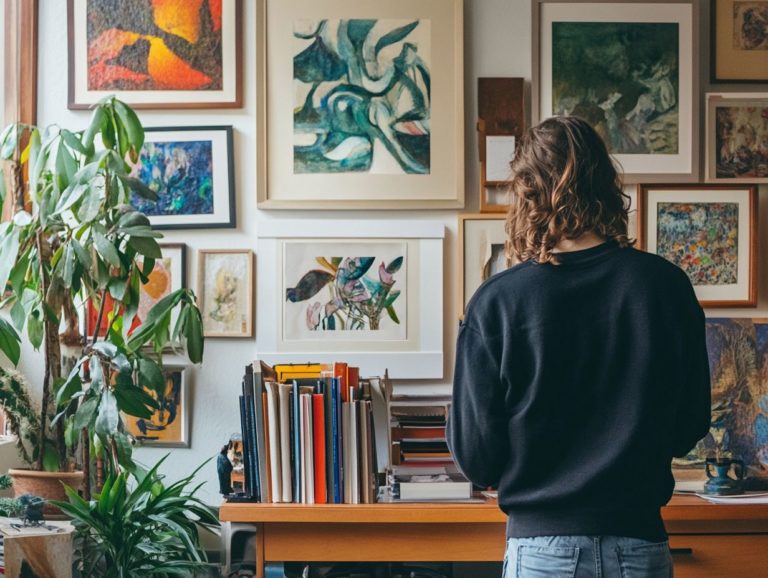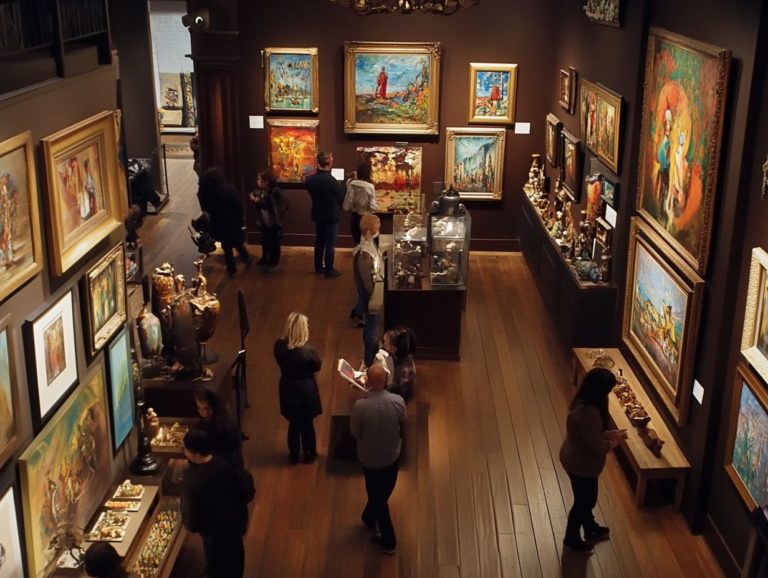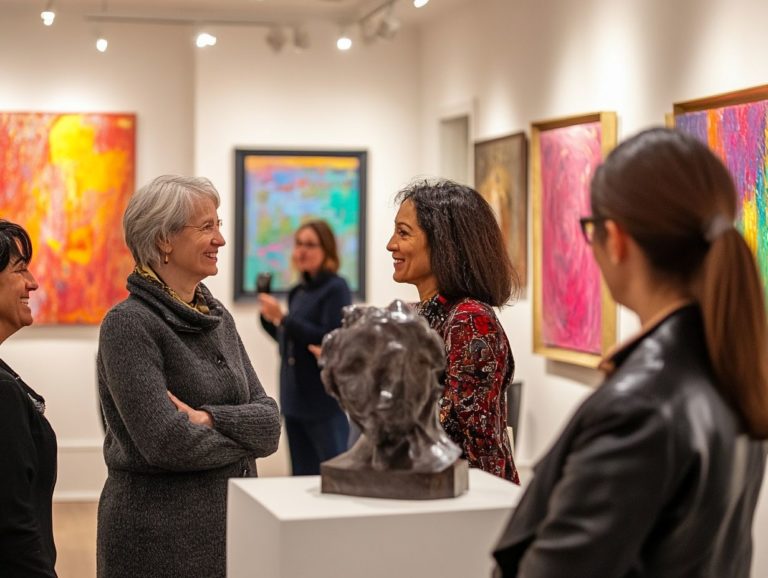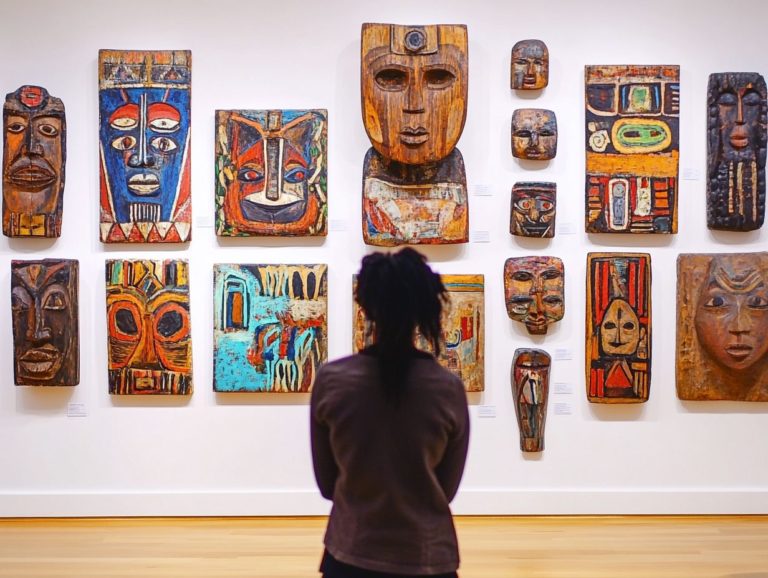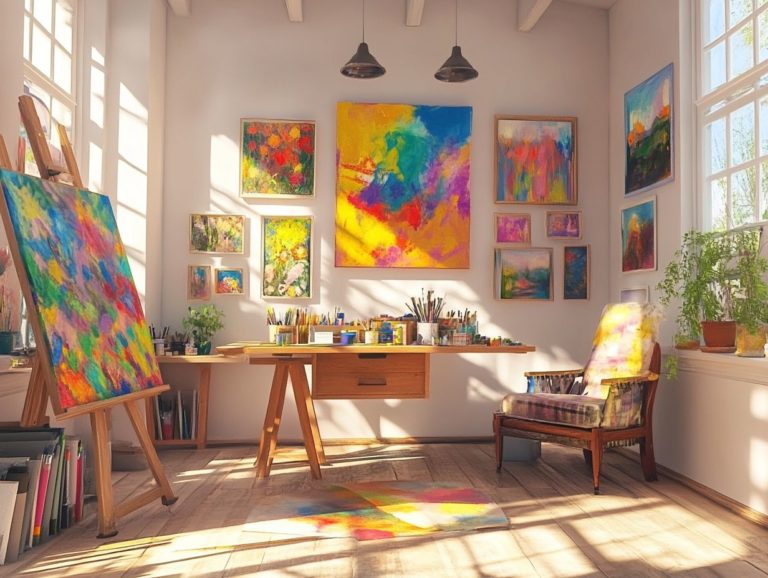The Rise of Collectible Art Investments
The world of collectible art investments is truly captivating, seamlessly merging cultural appreciation with financial potential.
As trends shift, you ll find that an increasing number of people are awakening to the unique benefits and inherent risks tied to investing in art.
This article delves into what collectible art investments are, exploring their rich history and the distinct advantages they present.
It also sheds light on potential pitfalls and offers insights on how to navigate them effectively.
Finally, it looks ahead to what the future may hold for this intriguing market. Prepare to discover the vibrant landscape of art investment!
Contents
- Key Takeaways:
- Understanding Collectible Art Investments
- History of Collectible Art Investments
- Benefits of Investing in Collectible Art
- Risks Associated with Collectible Art Investments
- How to Get Started with Collectible Art Investing
- The Future of Collectible Art Investments
- Frequently Asked Questions
- What is meant by “collectible art investments”?
- What has caused the rise of collectible art investments?
- What are the potential benefits of investing in collectible art?
- What are some risks associated with collectible art investments?
- How can one get started with collectible art investments?
- What are some notable examples of successful collectible art investments?
Key Takeaways:

Understanding Collectible Art Investments
Understanding collectible art investments is a nuanced journey that involves exploring market trends and buyer demographics, as well as the emotional rewards tied to owning distinctive pieces, including collectible investment trends you should know.
In today’s landscape, increasingly shaped by millennials and Ultra High Net Worth Individuals (UHNWI), the allure of art as an alternative investment has surged, especially in dynamic cultural centers like Hong Kong.
Collectible art, especially in contemporary and digital formats, has transformed into a thriving market that embodies the financialization of art, merging emotional significance with tangible investment returns.
What are Collectible Art Investments?
Collectible art investments involve acquiring unique pieces with the dual goals of financial appreciation and emotional enjoyment. This fascinating category spans a diverse array of artistic mediums, from contemporary art and classic masterpieces to the exciting realm of emerging digital forms like NFTs, appealing to a wide range of collectors.
As the art market evolves, your motivations for purchasing these pieces can vary greatly, whether driven by personal passion or the allure of substantial returns. You ll find that analyzing trends, identifying emerging artists, and gauging market demand are crucial steps that can significantly influence the value of your collection.
Thus, grasping the intricate interplay of cultural significance, artist reputation, and market volatility becomes essential for anyone considering these investments.
History of Collectible Art Investments
The history of collectible art investments unfolds as a rich tapestry, intricately woven with evolving market trends, cultural shifts, and the growing financialization of art across Asia and beyond, making it essential to explore understanding art market trends for collectors.
Picture the grand auctions orchestrated by esteemed houses like Sotheby s, alongside the vibrant emergence of art fairs such as Art Basel. Each milestone along this journey has played a pivotal role in shaping the global art trade.
With the rise of digital platforms, what was once a niche market now beckons a diverse array of buyers, from millennials to ultra-high-net-worth individuals, all eager to lay claim to coveted collectibles.
Evolution and Trends of the Market
The evolution of the collectible art market showcases significant shifts in buyer demographics, auction dynamics, and the burgeoning influence of digital art.
As traditional buyers often older and more conservative begin to step back, you ll find younger generations, particularly millennials and Gen Z, stepping into the spotlight, enticed by their passion for unique and accessible art.
Recent statistics reveal that over 70% of millennials view art as a vital investment, driving auction sales to unprecedented heights, with notable sales surpassing $500 million in recent months.
Platforms like Artsy and Saatchi Art are revolutionizing how art is bought and sold, allowing for seamless transactions across borders and connecting digital art collectors with emerging talents.
This fusion of technology and creativity is transforming how art is perceived, cultivating a more inclusive market that embraces both tangible and virtual realms.
Benefits of Investing in Collectible Art

Investing in collectible art offers many benefits, blending financial gains with emotional rewards that elevate personal satisfaction and deepen cultural engagement.
As the market thrives especially in art-centric cities like Hong Kong buyers are increasingly aware of art s dual significance as an investment vehicle and a source of enrichment in their lives.
The potential for appreciation, combined with the joy of owning unique pieces, makes this sector especially attractive to millennials and wealthy individuals.
They seek both financial returns and emotional fulfillment, aiming for a harmonious balance between the two.
Financial and Non-Financial Advantages
The financial and non-financial advantages of investing in collectible art are compelling, offering a unique blend of monetary gain and emotional enrichment.
As you explore this realm, consider the potential appreciation in value which has experienced impressive growth in recent years and the significant tax benefits that come with art ownership.
Current market data reveals that wealthy individuals increasingly diversify their portfolios with tangible assets like art, effectively reducing risks associated with traditional investments.
Beyond financial returns, you ll also experience profound satisfaction from owning pieces that resonate personally or reflect cultural significance.
For many, being part of the art community provides deep fulfillment that goes beyond mere investment, creating a legacy to share with future generations.
Risks Associated with Collectible Art Investments
Investing in collectible art is an exciting opportunity that can lead to significant rewards, but it’s crucial to recognize the inherent risks and potential pitfalls that can influence market performance and buyer sentiment.
As the market for contemporary and digital art continues to grow, you ll need to navigate challenges like fluctuating valuations, authenticity concerns, and market saturation all of which can complicate your investment decisions.
A deep understanding of these risks is essential, whether you’re new to the scene or a seasoned investor aiming to make informed choices about your art investments.
Potential Pitfalls and How to Mitigate Them
Recognizing potential pitfalls in collectible art investments is vital for safeguarding your financial interests and increasing your chances of success.
You may find yourself caught up in the thrill of acquiring pieces, only to overlook their true market value a classic case of overvaluation.
Impulse purchases can amplify this issue, leading you down a path of poor investment choices that yield little to no return.
To navigate these risks, a robust strategy involves thorough research and due diligence before making any acquisitions.
This means evaluating the artist’s market history and grasping current trends within the art world.
Successful investors often diversify their portfolios and seek guidance from seasoned art advisors, ensuring that their selections are rooted in informed decisions rather than emotional whims.
How to Get Started with Collectible Art Investing
Embarking on collectible art investing requires a strategic approach and access to various resources to empower your decision-making and enhance your investment success.
As millennials and wealthy individuals increasingly engage with this vibrant market, understanding the fundamental aspects of art investment becomes crucial.
By researching prestigious galleries and auction houses such as Sotheby s and Art Basel, and exploring online platforms for digital art sales, you can navigate this diverse landscape effectively.
Leveraging the wealth of available knowledge will enable you to make informed and discerning purchasing choices.
Now is the time to dive into art investing and explore the exciting opportunities available to you!
Steps to Take and Resources to Use

To navigate the world of investing in collectible art, follow structured steps. Use available resources to make informed decisions.
- Start by identifying your personal interests and preferences; this will help narrow down the overwhelming array of art options available.
- Next, dedicate time to researching reputable galleries and auction houses, as these venues often showcase a diverse selection of artworks and collections.
- Talking to experts in the field can provide you with invaluable insights and guidance. Professionals like art consultants and appraisers can help you grasp current trends and valuation methods.
- You can stay informed by using online platforms and databases, ensuring you understand pricing, history of ownership, and artist backgrounds before making any purchase.
The Future of Collectible Art Investments
The future of collectible art investments looks bright! Exciting trends are shaping the market, with evolving predictions and growing interest in digital art.
As cultural hubs like Hong Kong continue to flourish and high-profile events like Art Basel capture international attention, the landscape is destined for remarkable transformations.
Consider factors such as technological advancements, shifting demographics, and the growing financialization of art; these elements will influence your investment strategies and motivations in the years ahead.
Predictions and Factors Influencing the Market
Predictions for the collectible art market suggest you are on the brink of witnessing substantial growth, largely influenced by the rise of digital art and its seamless integration into unique collectibles beyond traditional art investment strategies.
Experts assert that as technology continues its rapid evolution, your preferences as a buyer will shift dramatically. The allure of non-fungible tokens (NFTs) has captivated both seasoned investors and new collectors, making digital mediums more accessible and enticing than ever before.
This surge of enthusiasm not only redefines what art investment means but also highlights the pivotal role of technological platforms in facilitating purchases. As the market embraces these innovative approaches, traditional boundaries dissolve, creating space for diverse forms of artistic expression to flourish.
Looking ahead, future trends indicate a harmonious blend of physical and digital art, propelling engagement and investment opportunities to unprecedented levels.
Frequently Asked Questions
What is meant by “collectible art investments”?
Collectible art investments refer to the purchase of artworks or pieces of art with the intention of generating a profit in the future. These investments can include paintings, sculptures, photographs, and other forms of art that have potential for appreciation in value.
What has caused the rise of collectible art investments?

The rise of collectible art investments is due to several factors, such as the increasing interest in art as an asset class, the growth of online art marketplaces, and the strengthening of the global economy. Additionally, some investors view art as a safer alternative to traditional financial investments during times of economic uncertainty.
What are the potential benefits of investing in collectible art?
- Potential returns on investment.
- Portfolio diversification.
- The enjoyment of owning unique and valuable pieces of art.
- Tax advantages, such as deductions for charitable donations and tax exemptions for long-term capital gains.
What are some risks associated with collectible art investments?
Like any investment, there are risks associated with collectible art investments. The value of art can be subjective and can fluctuate greatly based on market trends and economic conditions. Additionally, there is a risk of fraud and forgeries in the art market. Costs associated with buying, maintaining, and selling art can affect overall returns on investment.
Start your art investment journey today and explore the vibrant world of collectible art!
How can one get started with collectible art investments?
Getting started with collectible art investments can be daunting. Begin by researching the art market and learning about different kinds of art and artists.
Work with reputable dealers and galleries. Consulting art advisors and financial professionals can help you create a balanced investment strategy.
What are some notable examples of successful collectible art investments?
Many collectors have struck gold in the art market! For instance, Leonardo da Vinci’s Salvator Mundi sold for a staggering $450 million in 2017.
Claude Monet’s Nymph as en fleur fetched $84 million in 2018, while Pablo Picasso’s Les Femmes d’Alger (“Version O”) sold for $179 million in 2015.
These record-breaking sales highlight the potential for significant returns in art investments. Start your journey today to uncover valuable art treasures!


